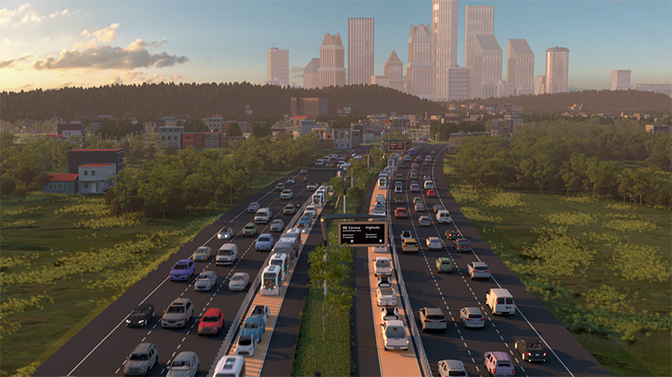
Advanced mobility is about more than technology. Our workforce should reflect that.
A new online course for professionals aims to shape a more holistic view of mobility.

A new online course for professionals aims to shape a more holistic view of mobility.
Originally published in the Detroit News, by Jim Sayer, lead faculty of the new online professional credential Foundations of Mobility, and director of the U-M Transportation Research Institute
For decades, many Americans have taken mobility for granted. The age of internal combustion engines, owning or having access to an automobile and going anywhere we want has been dominant in our lives.
That changed this spring. In addition to the heavy toll of death and disease brought by COVID-19, the pandemic has also kept us more stationary. By disrupting the movement of people, goods and services that are at the heart of our economy and society, it has made clear how foundational mobility is to quality of life.
The need for safe, equitable and efficient mobility solutions is more important than ever. The state of Michigan has long been taking steps in the right direction. On July 2, Gov. Gretchen Whitmer announced the launch of the Office of Future Mobility and Electrification. And on Aug. 13, she and partner organizations including the University of Michigan announced an initiative to develop a first-of-its-kind corridor for connected and autonomous vehicles in southeast Michigan. These are just the latest examples.

It’s paramount that these efforts operate from the broad perspective that mobility is about more than deploying technology and infrastructure — and that we begin to train the current and emerging mobility workforce to see the bigger picture.
Imagine that a company wants to set up a distribution center in a community. The state government offers a tax incentive because the center will create new jobs. But what about the mobility considerations? Is there adequate mass transit to the site so that the economically disadvantaged can work there? Does the local transit agency have to expand its service to the area? Will the roads be adequate to support increased traffic from employees and commercial trucks, or are road infrastructure improvements needed? Is there affordable housing nearby? What will be the environmental impact of the added traffic? How do you determine if there will be added safety risks to pedestrians or bicyclists?
Each of these questions requires the expertise of a different discipline, all focused on the general need for safe, equitable and efficient mobility.
Many of us are trained to work in one small area of the overall mobility system. We’re engineers that design automobile parts, manage roadway infrastructure and traffic control, or maybe oversee the logistics of getting goods from one place to another. But these are all pieces of a very complex puzzle, every piece of which has the potential to have broad environmental, economic, regulatory, and societal impacts.
We need to recognize that decisions made by experts in one field can have significant effects on many other areas. As an example, transportation and economic mobility are inextricably linked, even across generations. A recent Harvard study concluded that the longer an average commute in a given county, the worse the chances of low-income families there moving up the ladder. Indeed, where we site roadways and route buses has major implications for access to jobs, to food, to health care.
From a sustainability perspective, the transportation sector releases 28% of U.S. greenhouse gas emissions (GHGs), making it the largest contributor, according to the EPA. Mobility solutions have the potential to curb these emissions. Different ownership models for connected and autonomous vehicles have different carbon footprints, for example. Making public transportation and new mobility technology more accessible could also turn this upward trend around.
Mobility technologies are not without risks — threats of cyberattacks, data privacy breaches, crashes and the potential for increased vehicle or person miles traveled. As innovation takes shape, we need to be vigilant about its impacts, understand how to properly use it, and take steps to ensure that public policy keeps pace.
None of this is easy, especially in real time. Continuing education programs like the new Foundations of Mobility credential at the University of Michigan can help. The first-of-its kind series of two courses offers more than 40 hours of instruction about topics like safety, social and behavioral considerations, transportation data, mobility and the environment, legal considerations, infrastructure finance and community planning.
But if we want the next generation mobility workforce to recognize that successful solutions require a multidisciplinary approach, we need to take more of an ecosystems approach to mobility education across the board, so that each of us understands how our role influences the broader mobility landscape.